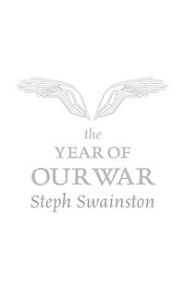Or so says Steph Swainston in a feature in Sunday’s Independent here. Coincidentally, I’d just read her first novel, The Year of Our War (see here), and as a result decided to track down its sequels. To date, there are three more books in the series: No Present Like Time, The Modern World and Above the Snowline. Swainston says there may well be more, but she’s asked her agent to negotiate her out of her current two-book contract, so who knows.
And the reasons she gives? Too much stress. The stress of producing a book a year. The stress of fans discussing her books on the internet. The stress of isolation. They are, to be honest, fixable problems. Actually giving up writing seems a somewhat drastic solution.
Different people write at different speeds, though publishers – and readers – do prefer a book per year. Publishing is, after all, a business. But see George RR Martin, Scott Lynch or Patrick Rothfuss – each of whom have multi-year gaps between volumes in their fantasy series. (Having said that, they probably had robust enough sales for publishers and fans to wait out those long delays.) Charles Stross was, at one, point, writing three books a year – though he has said, never again.
Different writers have different levels of engagement with the internet. Some are actively involved – with blogs or live journals, twitter accounts, forums, etc. Swainston appears to have almost no online presence. But then any level is sure to draw some sort of fire from some quarters. Not everyone on the internet is approving. The medium itself seems to rob many people of tact. Or intelligence. But being ignored is, I would have thought, more stressful. To not know what people think to your story can be disheartening – even a negative review means someone has at least engaged with your fiction. Of course, they may not be very nice about it in that negative review, but you can’t please all of the people all of the time.
Not everyone hides themselves away to write. Some write in their local coffee shop. Several writers I follow on twitter tweet from their local Costa Coffee or Caffè Nero. Others need total seclusion in order to write. I have, for instance, seen several conversations online regarding music and/or distractions when writing (not to be confused with displacement activites). Personally, I find extreme metal is the best music for me when I’m writing. Also, many published writers still have day jobs, and only write early in the morning, in the evenings, and on weekends. The issue for them is finding the time to write. Some writers have part-time jobs, giving them at least a a couple of days at home to focus on their fiction.
Then, of course, there’s the social side to genre writing. The conventions, the book launches, the parties… Not that these in any way characterise the life of a writer. But they do happen. I don’t believe Swainston is a con-goer, though she is Guest of Honour at next year’s Eastercon. Not every published writer engages with fandom in person, but many genre writers were actively involved in fandom before becoming writers and they haven’t withdrawn from it since turning professional.
In other words, there are lots of different aspects to the writer’s life, and lots of different ways of approaching those aspects. Swainston has chosen her solution. I don’t necesserarily agree with her choice, but it’s her choice to make. I still plan to read her books, and I do hope that she does continue to work on her Castle series – at whatever pace she feels comfortable. It’s always a shame when a talented genre writer turns away from writing. Swainston has a singular vision, and I think fantasy will be poorer for its loss – which is not something I can say of several writers of fantasy…

